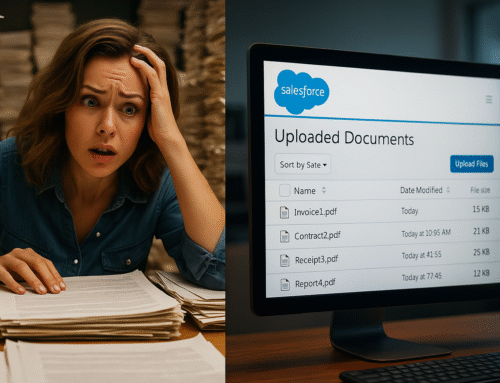
In today’s digital era, organizations are increasingly adopting cloud-based Customer Relationship Management (CRM) systems like Salesforce to streamline their operations and enhance collaboration. One critical aspect of CRM usage is document transfer and storage. Efficiently managing documents within the Salesforce platform and across various cloud-based systems can present unique challenges. This article aims to explore the intricacies and hurdles associated with document transfer and storage in Salesforce and other cloud-based CRM systems, providing insights and strategies to overcome these challenges.
1. Integration and Compatibility: One of the significant challenges organizations face when transferring documents within the Salesforce ecosystem or across multiple cloud-based CRM systems is integration and compatibility. Different systems may use varying file formats or storage protocols, making seamless integration and document exchange challenging. This can result in formatting issues, data loss, or incorrect interpretation of documents. To address this challenge, organizations must ensure that the CRM platforms they use have robust APIs and connectors that facilitate smooth document transfer and compatibility between systems. Salesforce provides a wide range of integration options and APIs, such as REST and SOAP APIs, making it easier to connect Salesforce with other CRM systems or external applications.
Real-life Use Case: Integration and Compatibility: ABC Company uses a cloud-based CRM system that stores documents in a proprietary file format. However, they need to transfer those documents to Salesforce for better collaboration with their sales team. By leveraging Salesforce’s robust APIs and connectors, ABC Company seamlessly integrates their CRM system with Salesforce, enabling the smooth transfer of documents in a compatible format.
2. Security and Compliance: Data security and compliance are paramount concerns when handling sensitive documents within CRM systems. Organizations must adhere to strict data protection regulations and maintain control over document access, sharing, and storage. Ensuring end-to-end encryption, user authentication, and audit trails become crucial in maintaining the confidentiality and integrity of documents. Compliance with industry standards such as General Data Protection Regulation (GDPR) and Health Insurance Portability and Accountability Act (HIPAA) is essential for organizations operating in specific sectors. Salesforce offers robust security features, including granular access controls, field-level security, and data encryption, to ensure data protection and compliance with various regulations.
Real Life Use Case: XYZ Healthcare is a healthcare provider that needs to transfer and store patient medical records securely within Salesforce. They utilize Salesforce’s encryption capabilities and fine-grained access controls to ensure that only authorized personnel can access and view sensitive patient information, adhering to HIPAA compliance regulations.
3. Scalability and Performance: As organizations grow and their document repositories expand, scalability and performance become significant challenges. Large volumes of documents can strain system resources, impacting transfer speeds and storage capacity. Efficiently managing document storage and optimizing system performance require careful planning. Organizations can implement strategies such as leveraging cloud-based file storage options, utilizing content delivery networks (CDNs) for efficient distribution of documents, and employing caching techniques to reduce latency. By utilizing these techniques, organizations can ensure smooth document transfer and storage, even with increasing volumes of data.
Real Life Use Case: EFG Corporation experiences rapid growth, resulting in a substantial increase in document volumes within their Salesforce instance. To ensure optimal performance, they implement a tiered storage hierarchy. Frequently accessed documents are stored in high-performance storage, while less accessed files are moved to lower-cost storage options. This approach allows EFG Corporation to manage their document storage efficiently and maintain system performance as their data grows.
4. Version Control and Document Collaboration: Effective version control and document collaboration are crucial for seamless teamwork and avoiding conflicts. Within the Salesforce platform and other cloud-based CRM systems, maintaining version control can be challenging, especially when multiple users are simultaneously working on a document. Without proper version control, it becomes difficult to track changes, merge edits, and ensure that the latest version of a document is readily accessible to all stakeholders. Salesforce provides features like Salesforce Files and content collaboration tools, allowing users to collaborate on documents in real-time, maintain version history, and leave comments. These tools enable teams to work together efficiently and ensure that everyone has access to the most up-to-date document versions.
Real Life Use Case: LMN Consulting employs a globally distributed team that collaborates on proposals and project documents stored in Salesforce. They utilize Salesforce Files to enable real-time collaboration, version control, and commenting features. This allows team members to seamlessly work together, track changes, and ensure that the most recent document versions are readily available to all stakeholders.
5. Search and Retrieval: Efficiently locating and retrieving documents is crucial for productivity and decision-making. As the number of documents within a CRM system increases, the ability to search and find relevant information becomes paramount. Salesforce offers advanced search functionalities, allowing users to search for documents based on keywords, metadata, or content within the document. Leveraging features like full-text search, filters, and tags can significantly improve document discoverability and retrieval. Additionally, organizations can integrate AI-driven search algorithms or implement enterprise search solutions to enhance search accuracy and provide intelligent recommendations based on user behavior and preferences.
Real Life Use Case: PQR Corporation, a manufacturing company, relies on Salesforce to store a vast array of product documents. With thousands of documents, finding specific technical specifications or user manuals becomes a challenge. By leveraging Salesforce’s advanced search functionalities, PQR Corporation can quickly locate and retrieve the required documents based on keywords, metadata, or even specific content within the documents, enhancing productivity and customer service.
6. Data Loss and Recovery: Unforeseen events like system failures, human errors, or cyberattacks can result in data loss. To minimize the impact of such incidents, organizations need to implement robust data loss prevention and recovery strategies. Regular backups are essential to safeguard critical documents. Salesforce offers automated backup solutions like Salesforce Data Recovery or provides integration options with third-party backup tools. These backup mechanisms ensure data redundancy and facilitate quick recovery in case of data loss. In addition to backups, organizations should also establish specific disaster recovery plans. These plans outline procedures for restoring data and services in the event of a catastrophic event. By regularly testing and updating these plans, organizations can ensure a smooth recovery process and minimize downtime.
7. Migration Challenges: Migrating documents from legacy systems to a cloud-based CRM platform like Salesforce can present several hurdles. Data format conversions, data cleansing, and ensuring data integrity during the migration process are key considerations. Organizations should develop a comprehensive migration strategy, including data mapping, transformation rules, and validation protocols, to ensure a seamless transition while minimizing the risk of data loss or corruption. During the migration process, it is important to prioritize data quality and accuracy. Organizations can leverage data cleansing tools and perform data validation checks to identify and rectify any inconsistencies or errors in the documents being transferred. By ensuring data integrity during the migration, organizations can maintain the reliability and usability of their documents within the new CRM system.
Efficiently managing document transfer and storage in Salesforce and other cloud-based CRM systems requires careful consideration of integration, security, scalability, collaboration, searchability, data protection, and migration challenges. By addressing these challenges proactively, organizations can harness the power of cloud-based CRM platforms to streamline their operations, enhance collaboration, and achieve their business goals.
References:
- Salesforce Documentation: https://help.salesforce.com/





